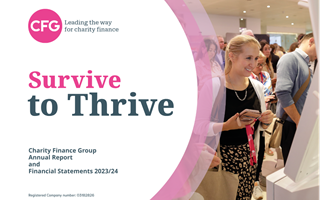We were recently asked by Third Sector to contribute to their article on creating meaningful impact reports. This got us thinking about how charities can transform what's often seen as a compliance burden into one of their most powerful strategic tools. And as we’ve just finished writing our own annual report, we thought we’d share some of the lessons we learned.

With additional regulatory support on the horizon for impact reporting in the form of the soon-to-be-finalised Charities SORP, now is the perfect time to elevate how they communicate their achievements. An effective impact report can be one of your most powerful tools for demonstrating value to funders, engaging supporters, and building organisational credibility.
Reframing the conversation
At a time when so many organisations are resource-strapped, it's understandable that impact reporting can feel like yet another task on an already overwhelming to-do list. But these reports will be viewed by funders, beneficiaries, current and prospective staff, and potentially the general public. A well-crafted impact report can be hugely beneficial for your organisation in terms of income generation and increasing your impact even further.
Think of it as an investment. The time spent creating a strong impact report can pay dividends through securing funding, attracting talent, and developing partnerships. Even better, the content you create can be repurposed throughout the year – impact stories can feed into case studies, fundraising appeals, and recruitment materials, maximising the return on your effort.

Year-round data collection
The foundation of any strong impact report is robust data collection, and this should ideally be a year-round commitment, not a last-minute scramble. Organisations should be systematically gathering both quantitative data and qualitative testimonials from beneficiaries, members, and supporters throughout the year.
Numbers need narrative context to become meaningful. A statistic about the number of people you’ve supported only resonates when accompanied by stories that illustrate the real human impact behind those figures. As we told Third Sector, numbers alone don't tell the full story, but weaving together quantitative evidence with compelling storytelling takes skill and time.
Make your data meaningful by using comparisons and context. Rather than simply stating "we supported 500 people", try "we supported 500 people – a 40% increase on last year" or "equivalent to one person helped every working hour." These framings help stakeholders grasp the true scale and significance of your work.
A collaborative approach: finance and comms
This exercise is where finance and communications professionals can create something truly powerful together. Both teams have that big picture view of the charity and its work, and combining their perspectives creates something far more powerful than either could produce alone. Finance teams understand the numbers and can ensure accuracy and compliance, whilst communications professionals can craft the narrative that brings those figures to life.
Getting under the skin of the numbers together, adding colour, and finding ways to tell the story in an engaging and compelling way – this collaborative approach transforms dry statistics into compelling evidence of impact.

Gathering organisational insights
When gathering insights for your report, cast your net widely within the organisation. Whilst department heads provide strategic perspective, frontline staff may have the richest understanding of day-to-day impact and direct relationships with beneficiaries. Their voices can add authenticity and detail that brings your work to life.
Interviews with members, supporters or beneficiaries can be particularly impactful, providing those aforementioned human stories that make your statistics resonate. And it’s also vital to be honest about challenges and learnings, as well as your successes. This demonstrates organisational maturity and shows funders and supporters that you're committed to continuous improvement.
Crafting content that connects with your audience
As you compile your material, look for recurring themes that characterise the year's achievements and challenges. These key messages should be woven throughout the report, and don't be afraid of repetition. Readers rarely engage with impact reports linearly – many will dip into specific sections relevant to their interests, so reinforcing core messages across multiple sections ensures they land with different audiences.
Whilst impact reports are inherently retrospective, they're also an opportunity to build momentum for the future. Including forward-looking elements such as upcoming initiatives that leadership teams are excited about, emerging priorities, or strategic ambitions, can help position your organisation as dynamic and forward-thinking rather than simply documenting the past.
Make it engaging (and accessible)
Visual storytelling significantly enhances impact reports. Organisations like Oxfam and WWF excel at using compelling photography to illustrate their work and create emotional connection. Where appropriate to your cause, invest in quality images that show your impact rather than just describing it.
Beyond photos, varying your content formats keeps readers engaged. Consider incorporating video testimonials, infographics, Q&A features with staff or beneficiaries, and data visualisations alongside traditional narrative text. While reports need to meet requirements, once you've covered those bases, there isn't much constraint on what else you can include. Have fun with it and use these different styles to really highlight your organisational successes.
Accessibility should be paramount too. Use clear navigation with a contents page and section headers, maintain consistent branding and design throughout, and consider accessibility requirements like dyslexia-friendly fonts, alt text for images, and PDF tagging. And if you have the time and resources, try to make your report available in multiple formats – interactive PDFs, webpages, and summary versions for busy stakeholders.

Maximising your investment
Finally, approach your impact report as a campaign asset, not just a document. Create social media snippets and pull quotes for wider distribution. Share internally with staff first to celebrate successes and build team pride. The content you've worked hard to create shouldn't just sit in a PDF gathering dust, it should work for you throughout the year.
Template sections where possible to save time in future years, and remember that a great impact report is a whole team effort. Involve the entire organisation by asking everyone what their highlights were. The smoother you make the process for people to contribute, the more likely they are to engage meaningfully with it.
The best impact reports balance rigorous evidence with compelling storytelling, celebrates successes whilst being honest about challenges, and ultimately make stakeholders feel connected to your mission. With proper planning and a year-round commitment to capturing your impact, your report can become a powerful tool for demonstrating your organisation's value and building support for your vital work.